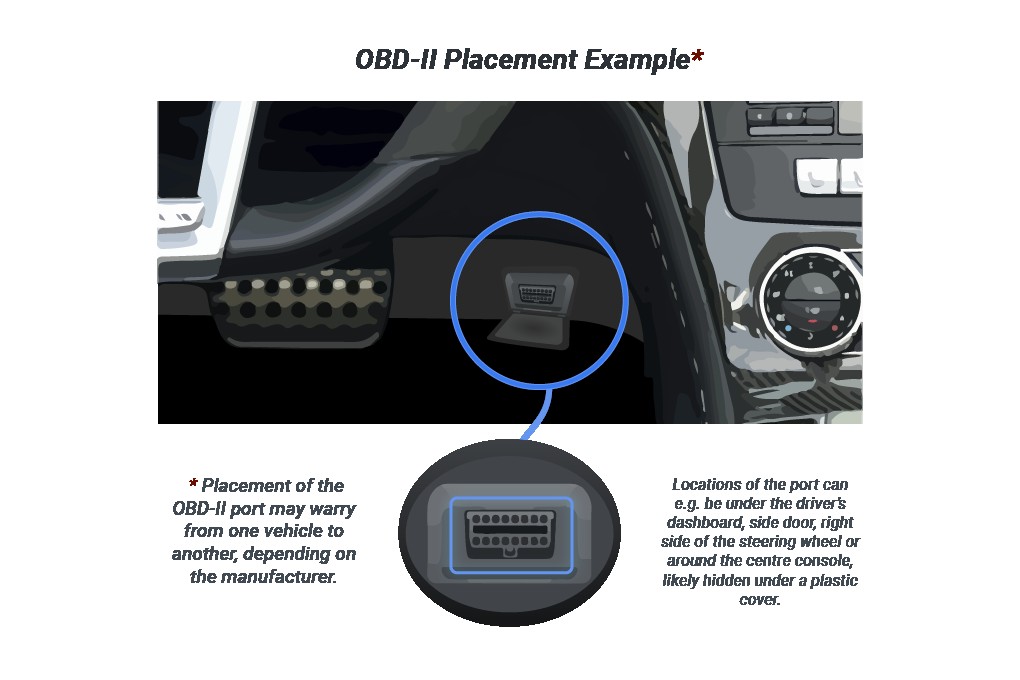The OBD2 port is your car’s secret weapon for self-diagnosis. Think of it as a direct line to your vehicle’s computer, providing access to vital information about its health and performance. Whether you’re a seasoned mechanic or a car owner wanting to understand those dashboard warning lights, knowing how to find the OBD2 port in your car is the first step towards effective vehicle diagnostics.
This port, standardized across most cars manufactured after 1996, is essential for connecting diagnostic scanners and tools. But for many, its location remains a mystery. This guide will illuminate where to find this crucial port, explain its importance, and get you started with basic vehicle diagnostics.
What is an OBD2 Port and Why is it Important?
OBD2 stands for On-Board Diagnostics version 2. It’s a standardized system that allows you to access your car’s computer and retrieve data related to various systems, including the engine, transmission, emissions, and more. The OBD2 port is the physical interface point for this system.
Why is it important? The OBD2 port empowers you to:
- Diagnose problems: When your check engine light comes on, an OBD2 scanner can read the error codes, helping you pinpoint the issue.
- Monitor vehicle health: You can track real-time data like engine temperature, speed, and fuel efficiency.
- Ensure emissions compliance: OBD2 systems are crucial for monitoring emissions and ensuring your vehicle meets environmental standards.
- Save on repair costs: By understanding the problem yourself, you can make informed decisions about repairs and potentially avoid unnecessary mechanic visits.
Where to Look for the OBD2 Port in Your Car
The OBD2 port’s location is designed to be accessible from the driver’s seat without tools. While the exact placement can vary depending on the make and model of your vehicle, it’s typically found in a few common areas within the car’s cabin.
Here are the most frequent OBD2 port locations:
Common OBD2 Port Locations
- Under the Dashboard (Driver’s Side): This is the most common location. Look beneath the steering column and around the knee area. It might be exposed or behind a small cover.
- Above the Pedals: In some vehicles, the OBD2 port is situated higher up, above the brake and accelerator pedals. You might need to look upwards and slightly under the dashboard.
- Inside the Glove Compartment: Less common, but some manufacturers place the port inside the glove compartment. Check the inner walls or ceiling of the compartment.
- Center Console: Though rarer, some models might have the OBD2 port located in the center console area, either near the gear shift or under the armrest.
Using Your Owner’s Manual to Find the OBD2 Port
The most reliable way to pinpoint the OBD2 port is to consult your vehicle’s owner’s manual. Look for sections on “diagnostics,” “OBD-II,” or “maintenance.” The manual should specify the exact location of the OBD2 port, often with diagrams.
Online OBD2 Port Finders
If you don’t have your owner’s manual handy, online OBD2 port finders can be helpful resources. These tools often allow you to input your car’s make, model, and year to suggest potential OBD2 port locations. However, always double-check visually to confirm the location.
Understanding the OBD2 Port Connector and Pinout
Once you’ve located the OBD2 port, you’ll notice it’s a 16-pin connector. This standardized connector, also known as a J1962 connector, ensures compatibility with a wide range of diagnostic tools and scanners.
Here’s a quick overview of what some key pins are used for:
- Pin 4 & 5: Ground. These pins provide the necessary grounding for safe and reliable data transmission.
- Pin 2 & 10: SAE J1850 BUS+ and BUS- (VPW/PWM). Used for communication protocols in some vehicles, allowing direct interaction with the car’s computer.
- Pin 6 & 14: CAN High and CAN Low. These pins connect to the Controller Area Network (CAN) bus, a crucial communication network within modern vehicles, used for diagnostics and various control functions as defined by ISO 15765-4.
Understanding the pinout isn’t essential for basic OBD2 port usage, but it’s helpful for those delving into more advanced diagnostics or custom projects.
How to Use the OBD2 Port Once You Find It
Using the OBD2 port is simple. Once located, you can:
- Plug in a Diagnostic Scanner: Purchase a compatible OBD2 scanner. These range from basic handheld code readers to more advanced professional-grade tools.
- Turn on Your Car’s Ignition: You don’t need to start the engine, just turn the key to the “ON” position (or press the start button without starting the engine).
- Follow Scanner Instructions: The scanner will guide you through the process of reading fault codes, viewing live data, and performing diagnostic tests.
By using an OBD2 scanner, you can decipher those cryptic warning lights and gain a better understanding of your vehicle’s condition.
Taking Diagnostics Further with Advanced Tools
While basic OBD2 scanners provide valuable insights, for deeper diagnostics and more advanced vehicle data access, consider tools like the AutoPi CAN-FD Pro. These devices connect to your OBD2 port but offer enhanced capabilities, including:
- Faster Data Acquisition: CAN-FD Pro allows for faster and more detailed data retrieval from your vehicle’s systems.
- Comprehensive Vehicle Insights: Gain access to a wider range of parameters and systems beyond basic OBD2 data.
- Advanced Projects: For developers and car enthusiasts, tools like AutoPi CAN-FD Pro open doors to custom vehicle data logging, telematics projects, and more.
FAQs
What if I can’t find the OBD2 location?
Double-check the common locations mentioned above, consult your owner’s manual, or use an online OBD2 port finder specific to your car’s make and model. If still unsure, consult a professional mechanic.
Are all OBD2 ports the same?
Yes, all OBD2 ports are standardized with the same 16-pin J1962 connector, ensuring compatibility across vehicles.
How many OBD2 ports does a car have?
Typically, a standard passenger car is equipped with a single OBD2 port.
Conclusion
Knowing how to find the OBD2 port in your car unlocks a wealth of diagnostic potential. It’s your gateway to understanding your vehicle’s health, troubleshooting issues, and even taking your car diagnostics to the next level. So, take a moment to locate your OBD2 port – it’s a small port with a big impact on your car maintenance journey.
Explore the world of OBD2 tools and automotive data solutions to empower yourself with vehicle knowledge and keep your car running smoothly for years to come!

